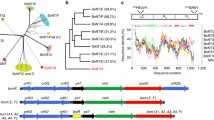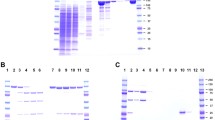Abstract
Botulinum neurotoxins (BoNTs) are the most toxic proteins known to cause flaccid muscle paralysis as a result of inhibition of neurotransmitter release from peripheral cholinergic synapses. BoNT type A (BoNT/A) is a 150 kDa protein consisting of two major subunits: light chain (LC) and heavy chain (HC). The LC is required for the catalytic activity of neurotoxin, whereas the C and N terminal domains of the HC are required for cell binding, and translocation of LC across the endosome membranes, respectively. To better understand the structural and functional aspects of BoNT/A intoxication we report here the development of high yield Escherichia coli expression system (2–20-fold higher yield than the value reported in the literature) for the production of recombinant light chain-translocation domain (rLC-TD/A) module of BoNT/A which is catalytically active and translocation competent. The open reading frame of rLC-TD/A was PCR amplified from deactivated recombinant BoNT/A gene (a non-select agent reagent), and was cloned using pET45b (+) vector to express in E. coli cells. The purification procedure included a sequential order of affinity chromatography, trypsinization, and anion exchange column chromatography. We were able to purify > 95% pure, catalytically active and structurally well-folded protein. Comparison of enzyme kinetics of purified LC-TD/A to full-length toxin and recombinant light chain A suggest that the affinity for the substrate is in between endopeptidase domain and botulinum toxin. The potential application of the purified protein has been discussed in toxicity and translocation assays.









Similar content being viewed by others
Abbreviations
- BoNT:
-
Botulinum neurotoxin
- BoNT/A:
-
Botulinum neurotoxin Type A
- DTT:
-
Dithiothreitol
- DNA:
-
Deoxyribonucleic acid
- DrBoNT/A:
-
Deactivated botulinum neurotoxin type A
- E.coli :
-
Escherichia coli
- EDTA:
-
Ethylenediaminetetraacetic acid
- FRET:
-
Fluorescence resonance energy transfer
- GST:
-
Glutathione-S-transferase
- HC:
-
Heavy chain
- IPTG:
-
Isopropyl-b-d-thiogalactopyranoside
- LB:
-
Luria–Bertani
- LC:
-
Light chain
- PCR:
-
Polymerase chain reaction
- RBD:
-
Receptor binding domain
- rLC-TD/A:
-
Recombinant light chain-translocation domain
- SDS-PAGE:
-
Sodium dodecyl sulfate-polyacrylamide gel electrophoresis
- SNAP-25:
-
Synaptosome associated protein of 25 kDa
- SNARE:
-
Soluble N-ethylmaleimide-sensitive factor attachment protein
- TD:
-
Translocation domain
References
Singh BR (2000) Intimate details of the most poisonous poison. Nat Struct Mol Biol 7:617–619
Schiavo G, Matteoli M, Montecucco C (2000) Neurotoxins affecting neuroexocytosis. Physiol Rev 80:717–766
Lacy DB, Tepp W, Cohen AC et al (1998) Crystal structure of botulinum neurotoxin type A and implications for toxicity. Nat Struct Biol 5:898–902. doi:10.1038/2338
Montal M (2010) Botulinum neurotoxin: a marvel of protein design. Annu Rev Biochem 79:591–617. doi:10.1146/annurev.biochem.051908.125345
Fischer A, Sambashivan S, Brunger AT, Montal M (2012) Beltless translocation domain of botulinum neurotoxin A embodies a minimum ion-conductive channel. J Biol Chem 287:1657–1661. doi:10.1074/jbc.C111.319400
Blaustein RO, Germann WJ, Finkelstein A, DasGupta BR (1987) The N-terminal half of the heavy chain of botulinum type A neurotoxin forms channels in planar phospholipid bilayers. FEBS Lett 226:115–120
Shone CC, Hambleton P, Melling J (1987) A 50-kDa fragment from the NH2-terminus of the heavy subunit of Clostridium botulinum type A neurotoxin forms channels in lipid vesicles. Eur J Biochem 167:175–180
Binz T, Rummel A (2009) Cell entry strategy of clostridial neurotoxins. J Neurochem 109:1584–1595. doi:10.1111/j.1471-4159.2009.06093.x
Montecucco C, Molgo J (2005) Botulinal neurotoxins: revival of an old killer. Curr Opin Pharmacol 5:274–279. doi:10.1016/j.coph.2004.12.006
Koriazova LK, Montal M (2003) Translocation of botulinum neurotoxin light chain protease through the heavy chain channel. Nat Struct Biol 10:13–18. doi:10.1038/nsb879
Fischer A, Montal M (2007) Crucial role of the disulfide bridge between botulinum neurotoxin light and heavy chains in protease translocation across membranes. J Biol Chem 282:29604–29611. doi:10.1074/jbc.M703619200
Fischer A, Montal M (2007) Single molecule detection of intermediates during botulinum neurotoxin translocation across membranes. Proc Natl Acad Sci USA 104:10447–10452. doi:10.1073/pnas.0700046104
Fischer A, Mushrush DJ, Lacy DB, Montal M (2008) Botulinum neurotoxin devoid of receptor binding domain translocates active protease. PLoS Pathog 4:e1000245. doi:10.1371/journal.ppat.1000245
Sathyamoorthy V, Dasgupta BR, Foley J, Niece RL (1988) Botulinum neurotoxin type A: cleavage of the heavy chain into two halves and their partial sequences. Arch Biochem Biophys 266:142–151
Chaddock JA, Herbert MH, Ling RJ et al (2002) Expression and purification of catalytically active, non-toxic endopeptidase derivatives of Clostridium botulinum toxin type A. Protein Expr Purif 25:219–228
Jensen MJ, Smith TJ, Ahmed SA, Smith LA (2003) Expression, purification, and efficacy of the type A botulinum neurotoxin catalytic domain fused to two translocation domain variants. Toxicon 41:691–701. doi:10.1016/S0041-0101(03)00042-4
Yang W, Lindo P, Riding S, Chang T, Cai S, Van T, Kukreja R, Zhou Y, Vasa K, Singh BR (2008) Expression, purification and comparative characterisation of enzymatically deactivated recombinant botulinum neurotoxin type A. Botulinum J 1:219. doi:10.1504/TBJ.2008.026477
Baskaran P, Lehmann TE, Topchiy E et al (2013) Effects of enzymatically inactive recombinant botulinum neurotoxin type A at the mouse neuromuscular junctions. Toxicon 72:71–80. doi:10.1016/j.toxicon.2013.06.014
Meyers JA, Sanchez D, Elwell LP, Falkow S (1976) Simple agarose gel electrophoretic method for the identification and characterization of plasmid deoxyribonucleic acid. J Bacteriol 127:1529–1537
Laemmli UK (1970) Cleavage of structural proteins during the assembly of the head of bacteriophage T4. Nature 227:680–685
Towbin H, Staehelin T, Gordon J (1979) Electrophoretic transfer of proteins from polyacrylamide gels to nitrocellulose sheets: procedure and some applications. Proc Natl Acad Sci USA 76:4350–4354
Feltrup TM, Singh BR (2012) Development of a fluorescence internal quenching correction factor to correct botulinum neurotoxin type A endopeptidase kinetics using SNAPtide. Anal Chem 84:10549–10553. doi:10.1021/ac302997n
Rasetti-Escargueil C, Machado CB, Preneta-Blanc R et al (2011) Enhanced sensitivity to Botulinum type A neurotoxin of human neuroblastoma SH-SY5Y cells after differentiation into mature neuronal cells. Botulinum J 2:30–48. doi:10.1504/TBJ.2011.041814
Chellappan G, Kumar R, Santos E et al (2015) Structural and functional analysis of botulinum neurotoxin subunits for pH-dependent membrane channel formation and translocation. Biochim Biophys Acta 1854:1510–1516. doi:10.1016/j.bbapap.2015.05.013
Mayer LD, Bally MB, Hope MJ, Cullis PR (1986) Techniques for encapsulating bioactive agents into liposomes. Chem Phys Lipids 40:333–345
Cai S, Singh BR (2001) Role of the disulfide cleavage induced molten globule state of type a botulinum neurotoxin in its endopeptidase activity. BioChemistry 40:15327–15333
Louis-Jeune C, Andrade M, Perez-Iratxeta C (2012) Prediction of protein secondary structure from circular dichroism using theoretically derived spectra. Proteins 80(2):374–381. doi:10.1002/prot.23188
Kumar R, Kukreja RV, Cai S, Singh BR (2014) Differential role of molten globule and protein folding in distinguishing unique features of botulinum neurotoxin. Biochim Biophys Acta 1844:1145–1152. doi:10.1016/j.bbapap.2014.02.012
Li L, Singh BR (1999) High-level expression, purification, and characterization of recombinant type A botulinum neurotoxin light chain. Protein Expr Purif 17:339–344. doi: 10.1006/prep.1999.1138
Lacy DB, Stevens RC (1997) Recombinant expression and purification of the botulinum neurotoxin type A translocation domain. Protein Expr Purif 11:195–200. doi: 10.1006/prep.1997.0772
Bolanos-Garcia VM, Davies OR (2006) Structural analysis and classification of native proteins from E. coli commonly co-purified by immobilised metal affinity chromatography. Biochim Biophys Acta 1760:1304–1313. doi:10.1016/j.bbagen.2006.03.027
Brunger AT, Breidenbach MA, Jin R et al (2007) Botulinum neurotoxin heavy chain belt as an intramolecular chaperone for the light chain. PLoS Pathog 3:1191–1194. doi:10.1371/journal.ppat.0030113
Todd C, Shine N et al (2005) Comparison of activity of botulinum neurotoxin type a holotoxin and light chain using SNAPtide® FRET substrates. In: 5th International conference on basic and therapeutic aspects of botulinum and tetanus toxins, List Labs Poster, Denver, CO. https://www.listlabs.com/mediafiles/posters/BTA-LcA-comparison-poster-4.pdf
Todd C, Shine N, Crawford K (2008) New high affinity antibodies against botulinum neurotoxin type A. In: 6th Annual ASM biodefense and emerging diseases research meeting, List Labs Poster, Baltimore, MD. https://www.listlabs.com/mediafiles/posters/Biodefense-poster--022108-8.pdf
Fischer A (2013) Synchronized chaperone function of botulinum neurotoxin domains mediates light chain translocation into neurons. Curr Top Microbiol Immunol 364:115–137. doi:10.1007/978-3-642-33570-9_6
Smith LSH (1988) Botulism: the organism, its toxins, the disease, 2nd edn. Charles C Thomas Publisher, Limited, Springfield
Clayton MA, Clayton JM, Brown DR, Middlebrook JL (1995) Protective vaccination with a recombinant fragment of Clostridium botulinum neurotoxin serotype A expressed from a synthetic gene in Escherichia coli. Infect Immun 63:2738–2742
Byrne MP, Smith LA (2000) Development of vaccines for prevention of botulism. Biochimie 82:955–966
Acknowledgements
This work was supported in part by a grant from the National Institute of Allergy and Infectious Diseases (NIAID—1U01A1078070-02) and by Maryada Foundation. The authors would like to thank Mr. Stephen J. Riding for his assistance in purification procedures. The authors also thank Dr. Gowri Chellappan for her assistance in liposome preparation procedures.
Author information
Authors and Affiliations
Contributions
Conceived the idea: NT, HD, BS. Designed and carried out the experiments: HD, NT, RK. Kinetics experiments: KP, GA. Analyzed the data: HD, RK, BS. Contributed reagents/materials/analysis tools: SC, BS. Offered comments on data interpretation and manuscript preparation: SC, RK, BS. Wrote the manuscript: HD, BS.
Corresponding author
Ethics declarations
Conflict of interest
The authors declare no conflict of interest.
Rights and permissions
About this article
Cite this article
Dhaliwal, H.K., Thiruvanakarasu, N., Kumar, R. et al. High Yield Preparation of Functionally Active Catalytic-Translocation Domain Module of Botulinum Neurotoxin Type A That Exhibits Uniquely Different Enzyme Kinetics. Protein J 36, 489–501 (2017). https://doi.org/10.1007/s10930-017-9744-8
Published:
Issue Date:
DOI: https://doi.org/10.1007/s10930-017-9744-8




